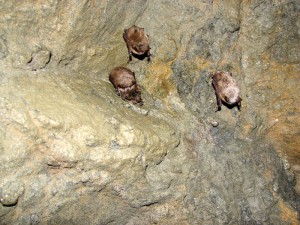On February 16, 2006, a recreational caver exploring Howes Cave in Albany, New York, photographed a bat with an unusual white growth on its muzzle. In the few years since that picture was snapped, hundreds of thousands of bats in North America have died from White-Nose Syndrome (WNS; 1,2).
The disease affects hibernating populations of bats, and has been found in the northeastern and eastern United States, as far south as Tennessee, as well as in the Canadian provinces of Quebec and Ontario (2).
Some suffering bats are emaciated with little or no body fat and have a characteristic white fungal growth on their wing membranes, ears and muzzles, hence the name “White-Nose Syndrome.” Instead of hibernating all winter, these bats can be seen active in the snow, when there is virtually no food available for them (1,2).
The white fungal growth observed on the bats is the result of infection with a previously undescribed cold-loving fungus,
Continue reading “When a Cold, Wet, White Nose Isn’t a Good Thing”
